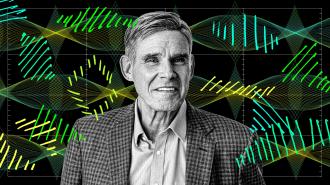Americans are getting older. By 2050, experts predict there will be more adults aged 65 and over than children under 18. And older often means sicker, especially in the U.S. The average American today celebrates just one healthy birthday after 65, according to the World Health Organization.
Caring for this growing segment of unhealthy elderly will require an unprecedented investment of time and money. Yet those immense costs could be significantly slashed with a sharp societal focus on healthy aging.
Acclaimed writer and medical researcher Eric Topol wants to be part of that pivotal effort. Right now, our elderly tend to be “illderly,” Topol writes. He wants them all to become “wellderly.” His new book, “Super Agers: An Evidence-Based Approach to Longevity,” offers a fantastic guide for how they can do so.
Topol, the director and founder of the Scripps Research Translational Institute, is one of the top 10 most-cited researchers in medicine. In “Super Agers,” he describes how advances in five areas — lifestyle, cells, artificial intelligence, drugs and vaccines, and omics (biology fields like genomics and microbiomics) — could increase our “healthspan,” or the number of years people live in good health, free from significant illness or disability.
By shifting social health along these lines, we can significantly reduce the big three age-related maladies: cancer, cardiovascular illness, and neurodegenerative disease. It’s a colossal task, yet as Topol told Freethink, he is more optimistic than ever that we can do it, thus narrowing the critical chasm between healthspan and lifespan.
When most people see a high-functioning 90-year-old, they assume that person won the genetic lottery. Your study of 1,400 healthy 80-plus-year-olds disproved this notion, failing to find strong DNA links to healthy aging. What stood out instead?
It’s not primarily in the DNA. If it were, we would have seen something obvious. The “lottery” is a possible explanation. But if we had to put everything we know together with age-related diseases, it’s most likely that they have an intact immune system.
The immune system is so vital in preventing the big three age-related diseases. You don’t see that in DNA. You basically have to look at how cells react to stimuli. You have to look at various parts of this complex immune system.
Everything points to that. The three big killers all have the immune system and inflammation as their core underpinning.
“The only thing we have that looks great is in mice. We don’t have stuff that works in people.”
Eric Topol
The narrative about inflammation has been taken over by purveyors of pseudoscience. But as you explain in your book, inflammation is a real issue. What causes inflammation, and how can we fight it?
You need inflammation when you have a cut or injury so you can heal. But when it’s doing untoward things, when you’re getting it where you don’t want it, it can lead to organ injury. For example, it could damage the arteries, so more atherosclerosis. It could lead to misfolded proteins in the brain, fostering Alzheimer’s.
As we get older, we’re more prone to inflammation, so-called inflammaging. Our immune system is also getting less functional — that’s called immunosenescence. So we get a lot of senescent cells as we get older, and these senescent cells can secrete highly pro-inflammatory proteins. In fact, one of the strategies being explored to reverse aging is to eliminate these bad senescent cells. The problem is that we’re not so good at only eliminating the bad ones.
Basically, lifestyle changes — diet, exercise, sleep — work through the immune system and inflammation.
With GLP-1 drugs, we’ve learned that their potency isn’t just that they help with diabetes or weight loss. Before they do that, they have a strong anti-inflammatory role in the brain and throughout the body. We’ve never had such a potent anti-inflammatory, and that looks like why it’s working across a range of diseases.
Do you think that more people should be taking these drugs?
We already know they’ll be bigger than statins. The question is, where’s the limit?
The common idea is that there’s a promise, but you’ve got to prove it. I’m not typically one who’s been pro-pharma. I’m normally taking on the pharma companies, but I can’t deny that the evidence is extraordinary and broad, and the side effects have appeared to be something that we can work with.
The big problem I have with these drugs right now is that they appear to be forever drugs. It’s great if you can get the weight off or get inflammation down to a low level. But to have to take any drug lifelong isn’t desirable.
You’ve long been a skeptic that we’d ever see anti-aging drugs, but you also say that you’ve changed your mind. When did that shift occur, and were there any specific breakthroughs that prompted it?
I went in totally skeptical, but I systematically reviewed every approach out there — from the most elegant, like partial epigenetic reprogramming, to senolytics, stem cells, telomere lengthening, rapamycin, and NAD+ supplements [NAD+ is a molecule linked to metabolic processes]. When I got through looking at all this, I realized there are so many “shots on goal.” There’s so much investment being made. The likelihood that something — just one of these — will help reverse the aging process and slow it down bodywide, I think it’s more likely that we’ll get there.
But we’re years away from it. Many people don’t understand that because of all the biohacking, false claims, and marketing. They don’t understand that the only thing we have that looks great is in mice. We don’t have stuff that works for people.
“If you’re a so-called longevity researcher or expert and you’re selling a supplement, you’ve already negated your credibility.”
Eric Topol
What are some examples of misplaced hype when it comes to fighting aging?
We have Bryan Johnson and his “don’t die” ideology. We have all these supplements that don’t have any anti-aging properties ever proven in a human being. We have longevity clinics charging $250,000 to have hyperbaric chambers and stem cells. There are plasmapheresis transfusions from young people. We have so-called longevity companies selling every test known — from getting a total body MRI to hundreds of blood tests. And on and on.
The hype is all over the place, and none of it is substantiated.
It’s so infuriating. It’s not regulated. They can say whatever they want. If you’re a so-called longevity researcher or expert and you’re selling a supplement, you’ve already negated your credibility because there are no supplements that have been shown in human beings to promote longevity.
Rather than focus on dubious supplements in your book, you write about aging remedies that actually yield substantiated results: exercise, diet, and sleep. What’s the best exercise regimen for improving your health?
We know much more about the benefits of exercise, diet, and sleep than we did just a few years ago.
For exercise, the data are compelling, and it isn’t just aerobic exercise, which I always used to recommend as a cardiologist. You know: 30 minutes of brisk walking or biking, five days a week. I did that all my life. I’ve been religious about it. Turns out, that’s not enough. It’s important, but you have to complement it with strength training, balance, and posture.
These are things that everybody can do: sit-ups, pushups, planks. You don’t even have to go to a gym, [but] they are important because they keep up your muscle mass, making it much less likely [you’ll] fall. The amount of time you spend on resistance training each week correlates with healthspan.
One other thing that’s really interesting: Steve Horvath, who is the pioneer of epigenetic clocks, found that the only thing that beneficially changes biological aging of a person is exercise. The other salubrious lifestyle changes are important, but so far, the signal for exercise is strongest.
What are the easiest dietary changes a person can make for the greatest benefits?
For one, a person certainly wants to try to reduce their ultra-processed food intake. That’s going to mean looking at labels; generally, the shorter the label, the better. A lot of food has all sorts of alien constituents. If you don’t recognize an ingredient, if it’s not in your kitchen, it’s probably bad for you. That’s rule number one.
The proven longevity diet is predominantly plant-based: reducing red meat and adding fruits, vegetables, and whole grains. That’s the Mediterranean diet, which is confirmed, even in randomized trials. It’s the only diet that’s gotten that confirmation across the board: less cardiovascular disease, less cancer, reduced rates of neurodegenerative disease.
Another big thing is not to overdose protein. Protein overdose is another pro-inflammatory problem. We’ve had some people out there who are advocating megadoses of protein per day — like one gram per pound of body weight. That’s not backed up by the data. You’re going to promote inflammation, and most of the time, you’re relying on animal-based protein. It’s not a good idea. More like one gram per kilogram is optimal.
It’s better to focus on fiber. If you get 25 grams of fiber a day, that’s what you’re looking for.
“We need a primary prevention moonshot.”
Eric Topol
This was surprising from your book: The optimal amount of sleep is seven hours. Why is sleep beyond this amount linked to health problems?
I went into the research thinking it was eight hours, so I was surprised to see that it wasn’t. We had the sleep math and metrics way off because it’s not time in bed that counts. Time in bed differs from time asleep, and time asleep differs from [length of] quality sleep. If you’re sleeping more than eight hours, it may not be good for you. It may be linked to depression or lack of physical activity. It isn’t always clear what the issue is that’s associated with that extra sleep.
Another big shock from the recent research: The drugs people commonly use to sleep, like Ambien, do not promote the efflux of waste products from the brain. They actually keep the stuff in the brain. It goes backwards. So, the last thing you want to do is take one of these medicines.
You write, “We’re stuck in the 1960s in our approach to cancer.” What do you mean by that, and how can we modernize cancer treatment?
It’s incredible that in 2025 we still treat all people as if they’re the same. Every woman aged 40 to 45 should go for a mammogram. Everyone above a certain age should get a colonoscopy. That couldn’t be further from the reality.
Eighty-eight percent of women will never have breast cancer. So why are we putting every woman through these screenings? We should be doing a risk assessment and tailoring cancer screenings according to the risk. It shouldn’t be age-specific. We now know young people can get cancers like colon and breast that don’t even fit these recommendations. The vast majority of these cancers are not getting picked up by these screens.
We’re wasting tens of billions of dollars with false positives, inducing unnecessary anxiety with unnecessary procedures. We’ve got to do better than this. It’s an unintelligent way to try to prevent cancer.
“Humans aren’t capable of dealing with all these data points for each person, but AI can.”
Eric Topol
You strongly advocate more frequent use of genetic testing in medicine, both for prevention and pathology. What are the benefits, and should genetic testing be part of routine checkups?
Getting a polygenic gene assessment of various common diseases can be done for less than $50. Then, you go to the next tier. Do you have a family history of cancer? When you add together the mother and father’s common gene variants, even without a family history, you’ll find that some people have a high predisposition to one of the common cancers.
Now, the next step: If there’s a potential signal, get a full-genome sequence, which can be done for less than $200. That will pick up all the so-called pathogenic mutations and all the susceptibility genes for cancer that we know. Now you’re rounding out the gene story, but you can also go further.
You can get an organ clock to tell if any of your organs are aging faster than the rest of your body. You can get a methylation clock to tell if your whole-body aging is out of whack. Then — and this will be in the future but is coming soon — you can get an immune clock assessment. If your chronological age is 60, but your immune system is like a 70-year-old’s, that’s a good sign that your immune system isn’t working properly, making you more vulnerable to cancer.
Between 1900 and 2021, the average global life expectancy surged from 32 years to 71 years. It’s now starting to level off, predominantly in developed countries. Yet, you seem optimistic that a confluence of advances — genetic testing, AI, personalized medicine — will get us back on track. Why?
I’ll start with what could prevent it. One is that our environment is getting worse all the time now. Our air pollution is unchecked. Microplastics and nanoplastics keep accumulating. And then, of course, there are forever chemicals and pesticides.
We’ve got a lot of problems we’re not addressing that we need to. It’s urgent. We’re going to make all this progress, and these are going to hold us back.
Let’s make combating the three main age-related diseases — again, cancer, cardiovascular, and neurodegenerative — our principal objective. We need a primary prevention moonshot. We’ve never done it before in the history of medicine. Prevention is so much more impressive for a person and [more economical] than trying to treat somebody or provide a cure.
We are in an extraordinary position to do this now because of “full-stack medicine.” We’ve got all these layers of data — genes, proteins, epigenetics, methylation markers, inflammation — that we didn’t used to have. We can apply all this with artificial intelligence. Humans aren’t capable of dealing with all these data points for each person, but AI can. It brings the data together and has unique attributes for disease forecasting with accuracy, precision, and timescales. It’s a new frontier for prevention. We need to validate it, of course, but it’s so exciting.
I’m just brimming with optimism because I know we can do this. We can flip the elderly from being the “illderly” to the “wellderly.” We have the resources in this country to make it a reality.
We’d love to hear from you! If you have a comment about this article or if you have a tip for a future Freethink story, please email us at [email protected].





















